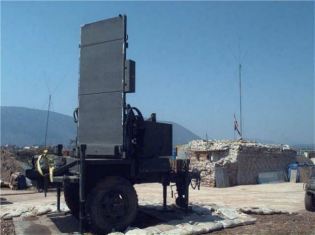|
The AN/TPQ-36 is a mobile radar system developed by Hughes Aircraft Company and manufactured by Northrop Grumman and ThalesRaytheonSystems. The AN/TPQ-36 is a highly mobile short range radar which can locate mortars, artillery and rockets within the accuracy of that weapons system. The AN/TPQ-36 was originally developed in the 70s and fielded in the early 80s. With high system reliability and maintainability simplified by computer-controlled, built-in test equipment, ThalesRaytheonSystems’ AN/TPQ-36 provides unusually high system availability. On-line fault detection and off-line fault diagnostics alert the operator to system faults, directing repair action to the unit that must be replaced. Ninety percent of all repairs required in the field can be performed by the crew, with a mean-time-to-repair of only 30 minutes. A total of 130 systems were built for the US Army and Marine Corps. The system has proven to be very effective in numerous situations and continues to be used by the Army, Marines, National Guard and many Foreign Military Sales Customers. The TPQ-36 is operated by the US Army (22) and the USMC (22), Portugal (2) , Turkey (4) which also purchased the -36(V)8 version and other NATO countries.
|
| Radar |
|
The AN/TPQ-36 comprises an antenna-transceiver trailer, a generator, and an operation control shelter that contains the paper map display and communications suite. The AN/TPQ-36 stationary antenna sweeps a rapid sequence of beams along the horizon, forming an electronic radar curtain over 90 degree area. Any target penetrating the curtain triggers an immediate verification beam. On verification, an automatic tracking sequence begins. While tracking any single target, the radar continues scanning, locating, and tracking others. The AN/TPQ-36 has been upgraded with a full radar compliance radar processor. The radar processor is common between the AN/TPQ-36 and AN/TPQ-37 Radars. The new processor reduces the number of circuit cards from 9 to 3. Customers benefit tremendously from the significant reduction in cost per unit and unlimited future growth potential. The open LAN based design accommodates future changes.
|
| Features |
|
The AN/TPQ-36 is an electronically steered radar, meaning the radar antenna does not actually move while in operation. The radar antenna may however be moved manually if required. The system may also be operated in a friendly fire mode to determine the accuracy of counterbattery return fire, or for conducting radar registration or mean point of impact calibrations for friendly artillery. Capabilities
- Locates mortars, artillery, and rocket launchers
- Locates 10 weapons simultaneously
- Locates targets on first round
- Performs high-burst, datum-plane, and impact registrations
- Adjusts friendly fire
- Interfaces with tactical fire
- Predicts impact of hostile projectiles
|
| Mobility |
|
The AN/TPQ-36 radar is mounted on two-wheels trailers which is towed by an Humvee control station vehicle. The prime movers for the system consists of three HMMWVs (Recon/Cargo Vehicle, Shelter Vehicle with Q-36 in tow, Generator Vehicle with spare generator in tow). For the U.S. Army, the 2,500 lb shelter is carried on a HMMWV or a 2.5-ton truck; however, it can also be carried by other tactical vehicles. T The manned operation control shelter can be located as far as 50 m away from the unmanned antenna trailer. The system is capable of being operated remotely 100 m from the shelter.
|
| Combat use |
|
ThalesRaytheonSystems’ compact, mobile, combat proven AN/TPQ-36 Firefinder radar accurately, rapidly and automatically locates medium-range enemy mortars, artillery, and rocket launchers. It can handle simultaneous fire from weapons at multiple locations, detecting and reporting their positions on the first round. The AN/TPQ-36 can detect and report the positions of up to 10 different weapons in seconds, at a maximum range of 24 km. The system also corrects and improves delivery of friendly fire. The mobile TPQ-36 Firefinder system can be set up in just 15 minutes, and removed and moving from the set up location in just 5 minutes. It is typically located close to the forward battle line in direct support of brigade operations. Locations of enemy weapon positions are automatically corrected for altitude differences, using computer-stored digital maps, and presented to the operator in northing, easting, and altitude coordinates. The system is so automatic and simple to operate that, once set up, the operator need not be present in the operation control shelter to determine a weapon’s location.
|
| |
| Specifications |
| Back to top |
|
Type
|
|
Mobile Counterfire target acquisition radar
a
a
a
|
|
Country users
|
|
Canada, Greece, Netherlands, Portugal, Singapore, Spain, Turkey, Ukraine, United States
|
|
Designer Company
|
|
ThalesRaytheonSystems
a
|
|
Accessories
|
|
Power generator
|
|
Crew
|
|
9 soldiers
|
|
|
Radar detection range
|
|
- 24 km maximum
- 18 km mortar detection effective range
- 14.5 km artillery detection effective range
- 24 km rockets detection effective range
|
|
Weight antenna/transceiver
|
|
1,452 kg
a
|
|
Support equipment
|
|
Recon/Cargo Vehicle, Shelter Vehicle with Q-36 in tow, Generator Vehicle with spare generator in tow
|
|
Set up time
|
|
15 minutes
|
|
Tracked aerial targets
|
|
10
|
|
|
|
| |
|





























